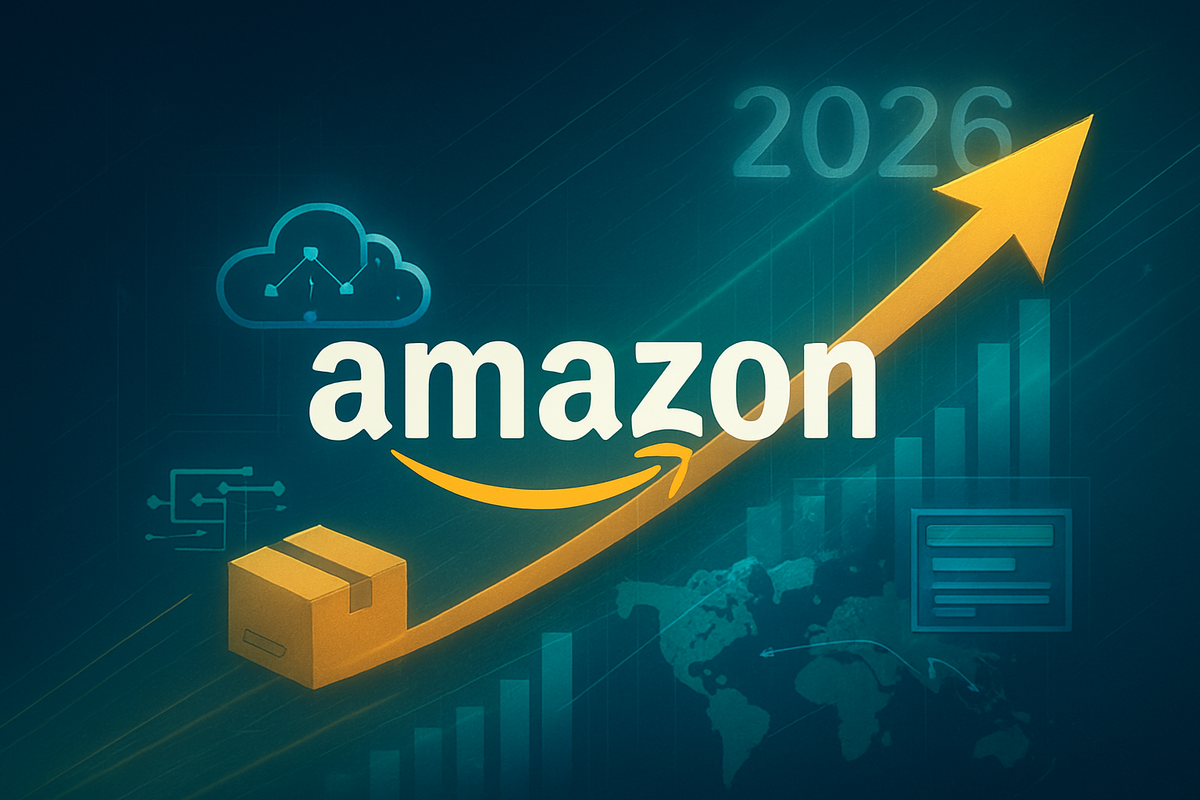
New York, NY – October 24, 2025 – Amazon (NASDAQ: AMZN) is generating significant buzz on Wall Street, with a flurry of analyst price target hikes signaling strong confidence in its potential for a substantial stock breakout in 2026. This optimistic outlook is fueled by an accelerating Amazon Web Services (AWS) business, soaring advertising revenues, and a revitalized, more profitable e-commerce segment, all underpinned by extensive artificial intelligence (AI) integration. The consensus among analysts remains a "Strong Buy," with average 12-month forecasts typically ranging from $264.64 to $269.03, implying a significant upside from current levels, and some bullish predictions reaching as high as $300.
The immediate market reaction to these positive revisions has been generally favorable, contributing to a palpable sense of optimism surrounding Amazon's future performance. For instance, on October 23, 2025, Amazon.com saw a 1.4% increase in its stock price, closing at $221.09, following several analyst target increases. This forward-looking sentiment suggests that investors are increasingly recognizing the company's strategic investments and operational efficiencies as key drivers for sustained growth in the coming year and beyond.
Analysts Eye 2026 as a Pivotal Year for Amazon's Ascent
Over the past few months, leading up to October 2025, a wave of prominent analyst firms have raised their price targets for Amazon (NASDAQ: AMZN), highlighting various growth catalysts. On October 24, 2025, Wedbush maintained an "Outperform" rating, increasing its price target from $250 to $280, a 12% hike, while Stifel maintained a "Buy" rating, raising its target from $260 to $269. Stifel specifically pointed to stable consumer spending and anticipated upward adjustments due to Fulfillment by Amazon (FBA) rate card changes for the holiday season, particularly in Third-Party Seller Services.
Just two days prior, on October 22, 2025, KeyBanc initiated coverage with a "Buy" rating and an ambitious $300 price target, implying over 35% upside. KeyBanc's analyst expressed a belief that investors are overly negative on Amazon's cloud business and expects cloud growth to improve significantly into 2026. This sentiment was echoed by Goldman Sachs (NYSE: GS) on October 3, 2025, which maintained a "Buy" rating and raised its price target from $240 to $275, a 14.58% increase. Earlier in the year, following Q4 2024 earnings, firms like Citi (NYSE: C), Canaccord Genuity, and DA Davidson also adjusted their price targets upwards, citing solid Q4 performance, robust holiday seasons, and strong year-over-year growth in AWS revenue.
The primary reasons cited for these elevated price targets revolve around Amazon's core strengths and strategic investments. Amazon Web Services (AWS) continues to be the primary profit engine, with strong growth rates (e.g., 17% in Q1 2025) and significant capital investments in technology infrastructure, especially for AI opportunities. Analysts believe AWS is exceptionally well-positioned in the AI revolution, with initiatives like gigawatt-scale data centers (Project Rainier) and key partnerships expected to boost revenue into 2026. Efforts to enhance e-commerce profitability through improved customer experience, low prices, expanding selection, and faster shipping are also key drivers. Furthermore, Amazon's advertising business is consistently showing strong growth (e.g., +19% in Q1 2025), contributing significantly to retail profits due to its high margins. Diversification into areas like same-day grocery delivery for Prime members and long-term projects such as Project Kuiper (satellite broadband) and Zoox self-driving cars, along with the deployment of AI foundation models to power its robotic fleet, are viewed as future growth catalysts.
The explicit focus on 2026 as a breakout year stems from several projections. Some analysts predict a 45% upside by the end of September 2026 and 24% annual total returns through 2030. Forecasts for 2026 vary, with some expecting the stock price to reach between $280 and $310 by the end of 2026 in a likely scenario. Operating cash flow per share is projected to spike by 23.7% in 2026 to $16.21, further supporting a bullish outlook. However, it's worth noting that Jeff Bezos is continuing a planned stock sale of up to 25 million shares by May 2026, which could influence supply dynamics, and intensified competition in the cloud sector, particularly in AI-driven areas, remains a consideration.
Ripple Effects Across E-commerce and Cloud Sectors
Amazon's (NASDAQ: AMZN) projected stock breakout in 2026, fueled by its dominant AWS, increasingly profitable e-commerce, and burgeoning advertising segments, is poised to send significant ripple effects across the competitive landscapes of both e-commerce and cloud computing.
In the e-commerce arena, competitors like Walmart (NYSE: WMT) and Target (NYSE: TGT) are likely to face intensified pressure. A stronger Amazon, projected to control over 40% of the U.S. e-commerce market by 2025, will make it harder for Walmart to significantly expand its own online market share, despite its faster e-commerce growth rate. Amazon's growing advertising platform may also divert digital ad spending from other platforms, impacting where Walmart might advertise its marketplace. Target (NYSE: TGT), with a smaller e-commerce footprint, could find it even more challenging to gain traction, and its retail media network, Roundel, will face formidable competition from Amazon's rapidly expanding ad business. However, this competitive pressure could also serve as a catalyst for innovation, compelling Walmart to accelerate its digital transformation, enhance its marketplace, and leverage AI for demand forecasting. Similarly, Target might further lean into its strengths, such as curated product assortments and its "store-as-hub" model for online fulfillment. Shopify (NYSE: SHOP), which empowers independent merchants, could find it harder to attract new sellers against Amazon's massive built-in audience, potentially leading to pricing pressure for its merchants. Conversely, Amazon's dominance might encourage businesses to seek greater brand control and diversification, turning to Shopify for multi-channel strategies and direct customer relationships.
In the cloud computing space, Amazon's continued AWS acceleration, particularly in AI workloads, will intensify the "cloud wars." Microsoft (NASDAQ: MSFT) Azure and Alphabet (NASDAQ: GOOGL) Google Cloud, while growing, will face an even more formidable challenge in closing the gap with the market leader. AWS's heavy investments in AI infrastructure, like Project Rainier, are designed to capture a significant share of the AI market, directly competing with Azure's and Google Cloud's own ambitious AI initiatives. Despite this, Azure's strong focus on hybrid cloud solutions and deep integration with Microsoft's enterprise ecosystem provides a resilient differentiator for large businesses. Google Cloud, while the fastest-growing among the "Big Three," still holds a smaller market share, and an accelerating AWS could make its catch-up efforts more demanding. However, Google Cloud's core strengths in AI, machine learning, and data analytics, along with its open architecture, could attract specific enterprise workloads and maintain its rapid growth trajectory.
Broader Industry Shifts and Regulatory Scrutiny
Amazon's (NASDAQ: AMZN) potential 2026 stock breakout is not merely a corporate success story; it's a powerful indicator of broader, transformative shifts across the technology and retail industries. This event would validate the accelerated evolution of e-commerce, with Amazon's continued investments in logistics and AI-powered customer experiences, including tripling its rural delivery network by the end of 2026, setting new benchmarks for speed and convenience. The company's reliance on third-party sellers (61% of paid units in Q2 2024) further solidifies its platform model.
In cloud computing, AWS's sustained dominance, holding a 30% global market share in Q2 2025, would underscore the critical role of cloud infrastructure in the digital economy, especially as enterprises increasingly adopt AI and machine learning workloads. The significant October 2025 AWS outage, however, serves as a reminder of the need for robust resilience and multi-cloud strategies, even for market leaders. The deep integration of AI across Amazon's operations—from custom silicon like Trainium2 to application-level services like Alexa+ and Amazon Q—would be validated by a breakout, showcasing the successful monetization of AI for efficiency and enhanced customer experience. Amazon's commitment of nearly $100 billion in AI initiatives in 2025, with its generative AI business already achieving a multi-billion dollar annual run rate, highlights its aggressive AI-first strategy.
The expansion of retail media networks is another trend amplified by Amazon's trajectory. As the leading force in this space, with its advertising business projected to generate $52.7 billion in revenue in 2024, Amazon benefits from stricter privacy regulations in 2025 compelling brands to rely more on first-party data. A breakout would further solidify Amazon's position as the third-largest ad platform in the U.S., behind Alphabet (NASDAQ: GOOGL) and Meta Platforms (NASDAQ: META).
This increased market power, however, comes with heightened regulatory and policy implications. The ongoing U.S. Federal Trade Commission (FTC) antitrust lawsuit, alleging monopoly power due to practices like raising seller fees, will intensify with a breakout. The FTC's case regarding Prime subscriptions, set for trial in October 2026, further highlights this scrutiny. A 2026 breakout could fuel calls for stronger antitrust enforcement, potentially leading to more aggressive litigation, increased fines, or even structural remedies. Concerns about data privacy will also amplify, particularly as Amazon leverages sophisticated AI and vast amounts of customer data for advertising and personalization. This could lead to demands for greater transparency, stricter consent mechanisms, and potentially new data ownership regulations.
Historically, Amazon's growth can be compared to the accelerated periods experienced by other tech giants like Apple (NASDAQ: AAPL) or Microsoft (NASDAQ: MSFT), which leveraged ecosystem effects and continuous innovation. While not a speculative bubble like the dot-com era, Amazon's breakout would signify the successful maturation of its multi-faceted strategy across e-commerce, cloud, and AI, demonstrating how its unique blend of physical and digital commerce continues to reshape global economic paradigms.
The Road Ahead: Opportunities, Challenges, and Strategic Imperatives
Following a potential stock breakout in 2026, Amazon (NASDAQ: AMZN) is poised for a dynamic future characterized by both immense opportunities and significant challenges, requiring strategic pivots and continuous adaptation.
In the short-term (2026-2027), Amazon will likely experience accelerated AWS growth, pushing past 20% due to surging demand for cloud services and generative AI workloads. The operationalization of "Project Rainier" in early 2026, aimed at building large compute capacity, will be crucial. E-commerce profitability will further improve through enhanced automation, AI-driven personalization, and optimized inventory management, leading to faster, more efficient delivery. Amazon's advertising revenue, projected to reach $94 billion globally by 2026, will cement its position as a central player in premium video and streaming ad markets, leveraging its vast first-party data for targeted precision. Deep AI integration will continue across all services, from AI-powered shopping assistants like Rufus to optimizing logistics and customer experience.
Longer-term (beyond 2027), AWS is expected to remain a critical pillar, potentially surpassing Amazon's e-commerce business in scale, driven by the global public cloud market projected to exceed $1 trillion by 2026. E-commerce will evolve into highly personalized and immersive experiences, incorporating voice commerce and augmented reality (AR). Amazon's advertising arm will expand beyond retail media into areas like Connected TV (CTV) and video ads, becoming a full-funnel activation platform. Global expansion and strategic diversification, including disrupting traditional industries, will remain core to its long-term vision.
To capitalize on this momentum, Amazon will need several strategic pivots. An "AI-first" development approach is crucial to accelerate its perception as an AI leader, requiring significant investments in infrastructure, talent, and R&D. Navigating increasing regulatory and antitrust scrutiny will demand a delicate balance between business objectives and compliance, potentially leading to adjustments in business practices and data privacy policies. Optimizing logistics and its workforce for advanced automation, aiming for up to 75% warehouse automation by 2033, will necessitate careful management of labor relations. Sustaining e-commerce growth will require continuous innovation in operational excellence, data-driven optimization, and agile tech stacks. Finally, a strong commitment to sustainability, including achieving carbon neutrality by 2040, will be vital for operating in an environmentally conscious world.
Market opportunities are vast, particularly in the expanding cloud computing market, the booming digital advertising sector, and the evolving e-commerce landscape with trends like AI-powered personalization and voice commerce. However, significant challenges include intense competition from other hyperscalers in cloud and strong rivals in e-commerce and advertising. Regulatory headwinds, high capital expenditures for AI infrastructure, potential labor disputes, and ever-increasing consumer expectations will also demand constant attention.
In terms of scenarios, a base case predicts continued strong growth, with AWS accelerating past 20%, improved e-commerce profitability, and rapidly ascending advertising revenue, leading to analyst price targets around $269.03 by 2026. A bull case envisions accelerated innovation and market dominance, with AWS capturing a disproportionate share of generative AI workloads and new, highly profitable e-commerce models emerging, potentially pushing the stock towards $350-$431 by 2030. Conversely, a bear case could see regulatory actions significantly impacting business models, intense competition eroding market share or margins, or escalating labor issues causing disruptions, resulting in slower growth and potentially lower stock performance.
Final Assessment and Investor Watch Points
Amazon's (NASDAQ: AMZN) projected 2026 breakout signifies a profound evolution from its e-commerce roots into a diversified technology conglomerate, underpinned by its formidable cloud infrastructure, advanced AI capabilities, and a rapidly expanding advertising platform. This multi-faceted growth story creates a resilient business model, less susceptible to fluctuations in any single segment. The strategic integration of AI across logistics, customer experience, and cloud services is fundamentally reshaping Amazon's operational DNA, setting new industry benchmarks for efficiency and personalized services. For the broader market, Amazon's trajectory underscores the increasing importance of integrated ecosystems, leveraging first-party data, and the pervasive impact of AI on both enterprise and consumer services.
Moving forward, the market is likely to view Amazon as a bellwether for innovation in cloud, AI, and digital commerce. Its ability to continuously leverage its vast data and technological prowess to create new revenue streams and optimize existing ones will be key to sustaining its leadership. The lasting impact of this period will be Amazon's solidification as a foundational player in the global digital economy, influencing how businesses operate and how consumers interact with technology.
Investors should closely monitor several key indicators in the coming months:
- AWS Growth Trajectory: Pay keen attention to AWS's quarterly growth rates, particularly the impact and ramp-up of capacity from "Project Rainier" in early 2026. Acceleration towards and beyond 20% growth will be a strong positive signal.
- E-commerce Profitability & Innovation: Watch for continued improvements in e-commerce operating margins and the success of initiatives like expanded same-day grocery delivery and the introduction of higher-margin retail categories.
- Advertising Revenue Expansion: Observe the sustained growth in advertising revenue, especially the performance of newer formats on Prime Video and the off-platform ad network. Continued double-digit growth will confirm its status as a core profit driver.
- AI Deployment and Partnerships: Look for updates on Amazon's AI integration beyond AWS, specifically how AI enhances efficiency in logistics, personalized shopping, and new product offerings. The success of partnerships like the one with Anthropic will be important.
- Regulatory Developments: Keep a close eye on the outcomes of ongoing antitrust challenges and regulatory investigations, particularly the FTC's case regarding Prime subscriptions, set for trial in October 2026. Regulatory decisions could lead to business model adjustments or fines. Also, note the new FBA policy effective January 1, 2026, which shifts prep and labeling responsibilities entirely to third-party sellers, potentially impacting seller relations and operational costs.
While some forecasts suggest a potential slowdown or reversal in stock trends after May 2026, the consensus among analysts remains overwhelmingly positive, citing Amazon's undervaluation relative to its fundamentals and immense growth potential across its diverse segments. Amazon's strategic investments and operational efficiencies position it as a compelling long-term investment, though vigilance regarding execution risks and the dynamic market environment remains paramount.
This content is intended for informational purposes only and is not financial advice





